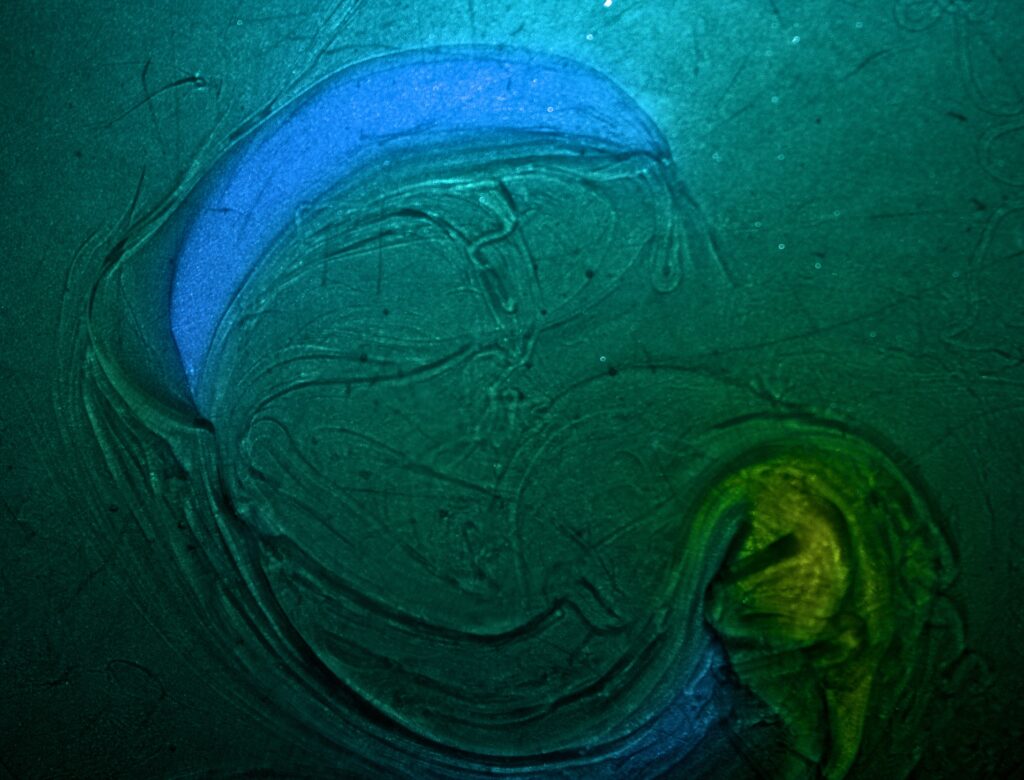The image above shows a layer of honey beneath a layer of water colored with blue dye. The significant difference in density between the two liquids allows them to stay separated into two distinct layers even when disturbed. To create the image, a spoon was dragged in a “C” shape motion through both layers across the bottom of the pan. The light blue areas are where the water has already returned to its steady state while the honey is still reforming due to its higher viscosity. Unexpectedly, the image also shows residual currents in the water along the path of the spoon as well as a small eddy that was created at the end of the spoon’s movement (bottom right). We are able to view this because of the difference in viscosity between the two layers. The water which “flows” more easily along the path of the spoon drags along the top of the honey layer creating a visual indication of the currents.
Will Norris Get Wet 2024-Difference in Viscosity
Categories
Flow Vis Guidebook
- Introduction to the Guidebook
- Overview 1: Phenomena. Why Does It Look Like That?
- Overview 2: Visualization Techniques
- Overview 3: Lighting
- Overview 4 - Photography A: Composition and Studio Workflow
- Overview 4 - Photography B: Cameras
- Overview 4 - Photography C: Lenses - Focal Length
- Overview 4 - Photography C: Lenses - Aperture and DOF
- Overview 4: Photography D: Exposure
- Overview 4 - Photography E - Resolution
- Overview 5 - Post-Processing
- Clouds 1: Names
- Clouds 2: Why Are There Clouds? Lift Mechanism 1: Instability
- Clouds 3: Skew - T and Instability
- Clouds 4: Clouds in Unstable Atmosphere
- Clouds 5: Lift Mechanism 2 - Orographics
- Clouds 6: Lift Mechanism 3 - Weather Systems
- Boundary Techniques - Introduction
- Dye Techniques 1 - Do Not Disturb
- Dye Techniques 2 - High Visibility
- Dye Techniques 3 - Light Emitting Fluids
- Refractive Index Techniques 1: Liquid Surfaces
- Refractive Index Techniques 2: Shadowgraphy and Schlieren
- Particles 1- Physics: Flow and Light
- Particles 2: Aerosols
- Particles 3: In Water
- Particles 4 -Dilute Particle Techniques
- Art and Science
- TOC and Zotpress test
- Photons, Wavelength and Color


4 Comments. Leave new
It feel as if it was a microscopic image of bacteria, really interesting
Hi Will, I like the cropping on your photo. It really enhances the swirling motion of your flow.
I like the way the photo was edited. The colors bring out the lines between the two fluids well. I also like this better as a photo than a video, even though this is a still, the photo captures the motion of the liquids well
Really interesting colors, theres a tricky sense of scale here which for me adds to the effect. Great highlighting of the flow with the shadows and lines